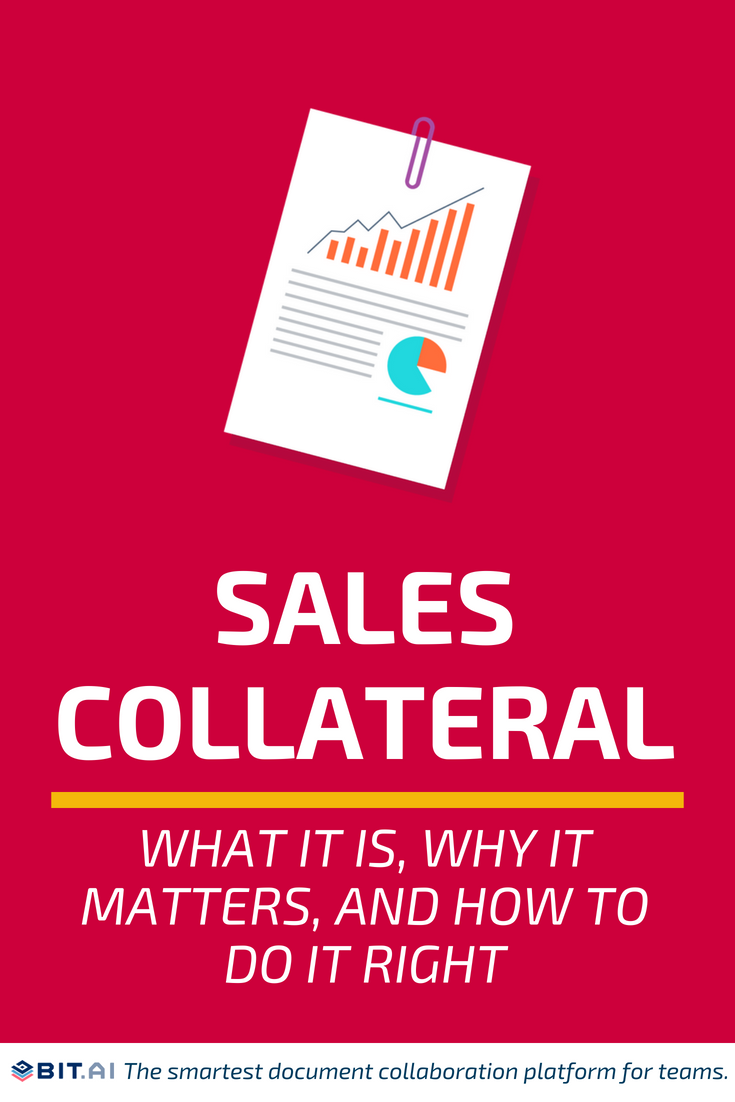Sales collateral is basically anything that helps move a prospect through the sales funnel. Sales collateral includes any type of printed or digital resource- information, media, or content that helps support the sales process.
The purpose of these materials is to give prospects, the information they need to decide to buy your product or service and help salespeople to support their cause through sophisticated case studies or presentations. Let’s see how providing your salespeople with everything they need can skyrocket your company revenue!

One of the biggest revenue-driving forces behind organizations is its salespeople. Your salespeople help your organization to grow by representing the company, going out in the field, interacting with customers, building relationships, establishing trust, and closing deals!
With such critical and massive responsibilities resting on their shoulders, salespeople need to be equipped with all the resources they would need to help them optimize interactions with clients and prospects, thereby closing more deals.
Even though salespeople have the most important job in your company- to drive revenue- salespeople say they lack the necessary knowledge to sell better and increase their close rates. This is where the need for creating top-notch and resourceful sales collateral arises.
Salespeople need to be equipped with all the knowledge, tools, and resources they need to get in touch with the prospects or customers, have meaningful relationships, and help them move down the sales funnel and close more deals.
Let’s see how creating awesome sales collateral can help your sales team achieve all that and more!
What Is a Sales Collateral? (Definition)
Today’s consumers are informed and more tech-savvy than ever. In fact, 70% of the buyer’s journey is completed before a buyer even reaches out to sales.
In a world of empowered customers, salespeople need to always be ready with the resources they need to close down more deals.
Therefore, businesses develop sales collateral to help boost the sales process. Companies use sales collateral with the aim of moving prospective customers through the entire process.

The many types of sales collateral range from traditional brochures, pricing sheets, website content, etc.
Must read: The Ultimate Guide To Sales Enablement Content
Types of Sales Collaterals:
The following are a few common types of sales collateral:
1. Product Data Sheets
Datasheets include vital information like:
- Target customers
- Information about pricing
- Features and benefits of the product
- Use cases
Datasheets are a handy resource for both salespeople and buyers as it answers most of the buyer’s questions instantly and speeds up the initial meeting.
The product and marketing teams need to work together to create a datasheet that is easy to read and understand and points to all the information clearly.
2. Brochures
Printed materials such as brochures, pamphlets, guides, and flyers are traditional forms of sales collateral.
Even with the digitization of the majority of the sales process, traditional pamphlets and brochures are still doing their job spreading the marketing messages!
3. White Papers
White papers are research-intensive and long-format content pieces. Although it takes more time to create long-form content, white papers act as lead magnets and are one of the primary tools marketers use to generate leads.
These detailed content pieces should be made available to new and established salespeople alike. Apart from gaining knowledge from the detailed content, the sales team can figure out the motivation behind a prospect for downloading the white paper can strategize their sale accordingly
4. Sales presentations & sales decks
A sales deck is an important aspect of the sales process. It is the tipping point that decides whether or not you are going to convert your prospects into customers. Thus, taking your sales deck seriously is a good call.
Sales decks are often used during the first major interaction with a prospect. Decks help describe the problems buyers face and how your product or service can help them overcome those challenges.
Every sales deck can be typically broken down into three parts:
- The problem that exists in the current scenario.
- The solution your company provides.
- And lastly, how they will their problem will be solved
Must read: Best Sales Deck Examples For Your Sales Team
5. Blog Content
By capitalizing on relevant keywords, marketers work hard to get in front of prospects and sell them on the valuable content they provide. Those valuable blog posts which prospects find useful should be made available to the sales staff as well.
By having the knowledge of what kind of content attracts which leads, the sales team can target their prospects coming from different marketing channels appropriately.

6. Case Studies
According to a study, 63% of marketers believe that case studies are effective marketing tactics.
Salespeople love to have a proof-of-concept at their disposal while meeting with prospects. Having case studies depicting the success previous customers have had with the product or service strengthens the sale.
In short, it adds credibility to the company, product, and service.
7. Sales Scripts
It’s very important for salespeople to have a reference point to keep the conversation in the right direction when talking to a prospect and make sure that all of the product’s value propositions are touched upon.
Giving a small list of talking points to the sales staff can go a long way in having a meaningful conversation with prospects. The length of information can, however, depend upon the experience the salesperson has.
For instance, a trainee or junior sales rep may need detailed help and be given a long-form script.
8. Email Templates
Did you know that only 24% of sales emails are opened? Sales teams need to have a set of pre-designed email templates to test their outreach campaigns and see what works and what doesn’t.
Marketers need to make sure that the sales team is equipped with plenty of email templates for various stages in a buyer’s journey. These include outreach, follow-up, check-in emails, etc. There must be an email template for every type of customer interaction.
Must read: The Beginner’s Ultimate Guide To Sales Prospecting
Tips For Creating Top-Notch Sales Collateral
Your prospects will interact with your sales collateral throughout their buying journey.
While the sales collateral alone might not close the deal, you still need to optimize it to the point that it might as well does! Here are a few tips that’ll let you do just that:
1. Collaboration is key
The creation of great sales collateral requires the efforts of both the marketing and sales departments. This makes the two departments work together, resulting in better alignment between the two.

Sales collateral typically originates in the marketing department, and the resources created by marketers are passed on to the sales department to assist in the sales process. Only with the input of salespeople can marketers create useful content that the sales team actually uses.
Even though it is obvious that quality sales collateral cannot be created in silos and requires sales and marketing to collaborate, a mind-boggling one trillion dollars is lost in sales due to lack of proper communication and collaboration between sales and marketing teams.
Both sales and marketing need to operate as a single unit, sharing data, insights, and creating valuable content, to close more deals.
Read more: How to Skyrocket your Sales with a Sales Dashboard (Template Included)
2. Make content easily accessible
Here’s a great tip for you- creating sales collateral won’t magically help them sell more effectively. You need to make the right content accessible to the right person at the right time for it to be worth the effort.
A shocking 80% of marketing content is rarely or never used by sales, according to ITSMA. Without proper guidance and training on how to make use of resources, the sales team can’t execute strategies effectively.
Management needs to make sure that sales reps are equipped with all the resources they need, as well as keep a tab on which sales materials are being used and which are not.
3. Involve your salespeople
Your salespeople are the ones who interact with your prospects on a day-to-day basis. They are the most familiar with their needs, wants, and problems. No survey or case study can bring you such intimate insights on your customers than your sales reps.
Thus, it only makes sense to involve them in the creation of sales collateral and value their opinions and feedback. Ask your salespeople whether the sales collateral is actually helping them close more deals or not.
Do they have the content they need for every stage of the buying cycle? Are they able to answer all buyer questions effectively?
Create content that forges a strong connection between sales reps and customers and allows them to use the type of content that fits their selling style, instead of pushing boring sales pitches.
4. Don’t forget about your customers!
While creating sales collateral, we are so focused on the effective alignment between sales and marketing, that we often forget about the most important aspect of this whole exercise- the customer!
To create sales collateral that stands out from the crowd and speaks to the customers on an emotional level, you need to truly understand your customer’s pain points.
Reverse engineer your customer needs and wants and try to create sales collateral in a language they understand and can relate to.
5. Keep content up to date
Sales reps use on average more than 17 pieces of content to enable the selling process. That sales content must be relevant, meaningful, and shared at the appropriate time to assist the buyer on their journey.

Keeping this content up-to-date is a must for salespeople to deliver accurate information to the prospects. Remove outdated collateral and provide only the latest.
Verify that your content is all up-to-date with regard to your company’s information like company logo, taglines, color schemes, etc. Are there multiple versions of one sales pitch? Are you using last quarter’s prices in brochures? Make sure that answers to these questions are a firm NO!
Conclusion
Sales reps need to have the right tools to be good at what they do and do it efficiently. Equipping them with great sales collateral is the foundation of forming a great sales team.
Apart from helping the sales process and educating prospects, the creation of sales collateral also forces sales and marketing to work together collaboratively towards a common goal. Without their joint effort, no great sales collateral can be created effectively.
Great sales collateral, in turn, drives revenue and helps creates more meaningful relationships with customers.
What are your thoughts on sales collateral? Does your company produce great sales collateral? Share with us in the comments below!
Further reads :
- 10 Must-Have Tools For Sales And Marketing Teams For 2022
- Tripwires: Definition, How To Include Them & Examples!
- 12 Sales KPIs Your Sales Department Should Measure!
- 9 Sales Collateral Examples You Should be Using in 2022
- How To Create A Sales Process Document The Right Way!
- How To Create Sales Content Assets For More Leads!

Related posts
Bit.ai | Watch to Learn More
What is Bit.ai?
Bit.ai is an innovative AI-driven knowledge and Document Managment suite designed to empower knowledge workers by streamlining the creation of, documents, wikis, and notes. With an intuitive interface and seamless integration, Bit.ai acts as a versatile assistant to help you collaborate, generate, organize, and visualize your ideas effortlessly. Whether you are drafting a report, managing a project, collaborating with your team or clients, or brainstorming new concepts, Bit.ai brings intelligence and creativity to every aspect of your work process.



